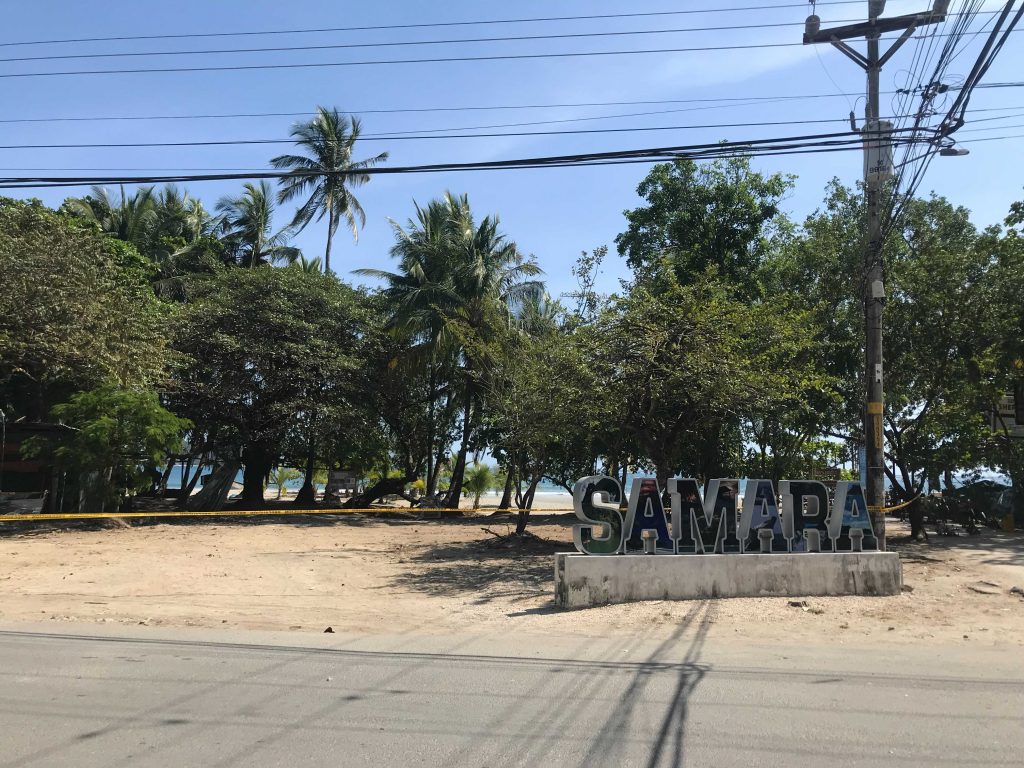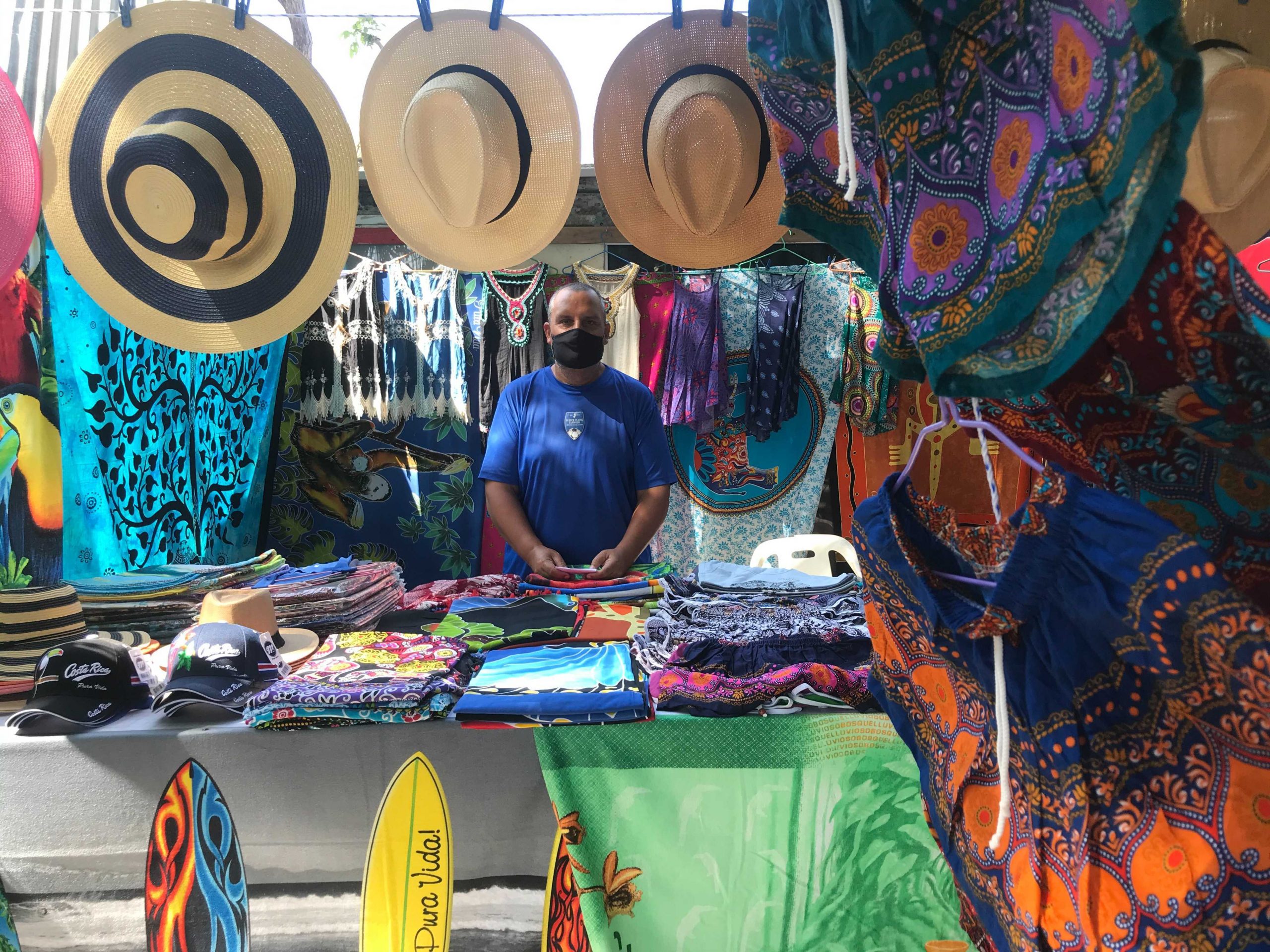
Elias Madrigal places a table full of things at the entrance of a shack facing the beach in Samara. With no customers, hidden between palm trees and surfboards, he misses the place where he used to sell his products. For eight years, his clothing booth was one of the first things tourists saw when they came to the beach, but it was also his only source of income, until the Municipality of Nicoya demolished it on February 11.
Along with Elias, seven other businesses that were set up illegally in Samara’s maritime land zone (ZMT- zona marítimo terrestre) met with the same fate.
Years after it went into effect, the municipality decided to take action to apply article 13 of the Maritime Land Zone Law, which authorizes local governments to evict, destroy and demolish any structure located within the zone. In the words of the mayor of Nicoya, Carlos Armando Martinez, it’s a task that the municipality “wasn’t managing adequately.”
At least five of the evicted vendors returned to the beach just two days later, walking around as street vendors or setting up near the entryways of cabins facing the coast. For most of them, selling merchandise in the booths was their only source of income to support their families.
The municipality collected the names and information of all the vendors, promising to offer a solution, but at this time, there isn’t a specific plan to help those affected.
***
The ZMT is the 200-meter wide strip along the beach, starting from the line that marks the highest tide. The law stipulates that it is divided into two sections: the first 50 meters of public area where no one can build anything and the remaining restricted area, where the municipality can grant construction concessions.
According to documents given to The Voice of Guanacaste by vendors, the Maritime Land Zone department sent an eviction order on Monday, February 8. In the order, the municipality demanded the immediate demolition of the premises across from the Samara police station and the removal of every kind of merchandise from the booths.

The municipality plans to build a shopping center to formalize businesses in the area. Currently they have the land across from the district police station fenced off. Credit: Yamlek MojicaPhoto: Yamlek Mojica
In light of the absence of compliance, three days later, the municipality proceeded to demolish the structures, as required by the ZMT law.
***
Elias said that when he started working in Samara in 2013, municipal authorities warned him that his clothes stand “wasn’t going to last more than three months.” Since then, the vendor has tried unsuccessfully to legalize the status of his business.
I would go from time to time to talk to the municipality so that they would give us permission to be [at the entrance to the beach], because some [vendors] have been here for up to 15 years and we wanted to become stable. They told us that it wasn’t possible, but that in the meantime while they resolved matters, we were there,” he related.
That’s also the case for Juan Carlos Diaz, who has sold crafts at the beach’s entrance for 14 years. Juan Carlos said that “everyone [in Samara] knew that there were location problems,” but that in light of the lack of action by authorities, the vendors “got used to being there.”
We asked them to help us legalize our business many times, but they didn’t tell us anything, so we just stayed,” Juan Carlos denounced.
Both vendors affirm that the change in dynamics significantly reduced their income. Elias, for example, went from selling about ₡70,000 (about $115) a day in products to ₡20,000 (about $35) in the last four days.
Rodrigo Acuña, coordinator of the ZMT department in Nicoya, admits that the municipality does have responsibility because the demolition wasn’t carried out until now, even though these structures have been there in violation of the law for years.
The thing is that the law has existed since 1977, so it’s true that there is a lag (in its application), but what we do [demolishing these businesses] is about the law. There it would be necessary to acknowledge fault in the administration. And I speak of it in a broader sense, not just this department, but all the actors within the administration that have to do with ZMT,” the official admitted.
Other Structures Remain Standing Along the Coast
The sales booths across from the police station were the only structures demolished in the ZMT, even though Acuña stated that other businesses also encroach upon the public area and have not been given eviction notices.
After visiting the place, The Voice of Guanacaste was able to confirm that at this time, multiple restaurants set up chairs and tables on the beach to serve the public in the maritime land zone.
As another example, 20 kilometers (12 miles) southeast of Samara, almost two years after the investigative report done by The Voice of Guanacaste about the illegal construction of a ranch in Garza Beach’s ZMT, the building remains standing despite multiple closure orders issued by the municipality. Currently, the Environmental Prosecutor’s Office is investigating the property’s owner for the crime of usurpation of property in the public domain.
To Acuña, the demolition of the booths in Samara was the first step in “recovering the public area of the beach,” but he doesn’t mean it will be the last. According to the official, the municipality is analyzing the situation of each property and establishment “case by case” so that in the coming weeks, they will begin to send notifications of eviction or removal of furniture, according to each situation.
Right now, we haven’t notified any other business because there are different legal situations that we continue to analyze. It’s not just that we’re going to proceed to demolition, but rather there are consequences for each legal entity that we have to assess. But it’s not that the process isn’t going to continue with them as well,” explained Acuña.
Abuse of the ZMT Law Puts People at Risk
Omar Lizano, a researcher at the Center for Research in Marine Sciences and Limnology at the University of Costa Rica (UCR), said “it’s useless” to evict informal booths when other businesses set up furniture in the ZMT.
If we’re going to remove some, the municipalities have to remove everyone. Because, from the oceanographic point of view, all those restaurant chairs and tables will be swept out to sea in the near future and there will be no excuse for [removing] this place, yes, and not the other. In 30 years, the tide is going to continue to rise and that is going to wash it away without further ado,” emphasized the expert.
Acuña affirmed that the aim of the eviction is also free movement on the beach. He thinks that many people involved have appropriated public space for years, leaving little land for the rest.
“In the end, this is a public area and it has free passage. If you’re obstructing that area that is free for all, you could lose your concession. The public area is a place for everyone and [people] have to begin to understand the limitations,” the official reminded.
Lizano emphasized that Samara’s case is special because before the earthquake in 2012, the district suffered serious erosion problems, due to which the ocean was slowly eating away at the Samara coast. Tamarindo experiences the same problem.
According to the scientist, the earthquake reversed those problems, but it’s still a very vulnerable coastline. Eventually the shoreline will continue to advance towards the town. That’s why structures and furniture shouldn’t be located in areas so close to the tide since they run the risk of flooding.
“It’s not that we are going to affect the ocean. It’s that the ocean is unstoppable and it will end up appropriating those spaces. So we can’t accommodate ourselves in vulnerable areas in any way,” he stated.




Comments